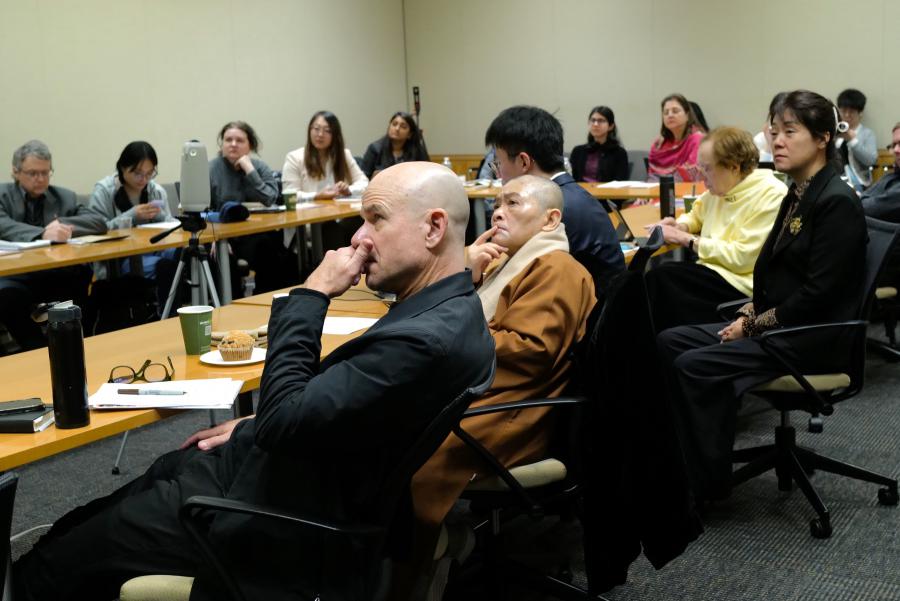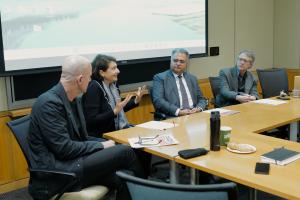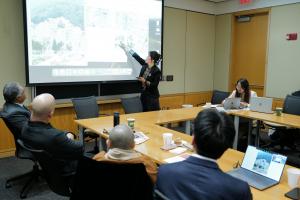
WAKSAW Co-Sponsors International Symposium on the Buddhist Heritage of Gandhāra at Harvard University
The March 23 symposium marks the international consortium’s latest collaboration with key global partners to advance Buddhist studies and research
NEW YORK, NEW YORK, UNITED STATES, March 28, 2024 /EINPresswire.com/ -- A recent event held at Harvard brought together the brightest minds in Buddhism civilizations research and studies. The International Symposium on the Buddhist Heritage of Gandhāra was held from 9 am to 5 pm on March 23 at Harvard University Asia Center. WAKSAW-Uddiyana Archaeological Alliance was a co-sponsor for the symposium along with the Harvard University Asia Center and Woodenfish Foundation.
WAKSAW, an international consortium, focuses on exploring Buddhism's history and promoting cultural heritage through research, collaboration, community outreach, and advocacy, highlighted by its recent symposium sponsorship. The symposium featured discussions from renowned academics and guests.
The workshop commenced with Professor James Robson, a distinguished scholar, educator, and author, who also serves as the newly appointed director of the Harvard-Yenching Institute (HYI) and holds the prestigious title of James C. Kralik and Yunli Lou Professor of East Asian Languages and Civilizations. He offered insightful opening remarks before taking on his role as the moderator for the day's academic workshop.
Dr. Ghani-ur-Rahman of the Institute of Asian Civilizations and a professor at Quaid-i-Azam University Islamabad was the first to speak. The talk “Gandharan Buddhist Art: Origin, Theme, and Iconographic Symbolism" explored Gandhāra Sculpture as a dialect of the Spiritual language of Buddhism and an effective medium to propagate the worldly mission of the Buddha Śākyamūni. Ghani-ur-Rahman explored different views on the origin of the Buddhist art of Gandhara and shared Iconographic Symbolism and Socio-Religious Background selected scenes from the life of Buddha carved in the stone sculptures of Gandhara.
The second morning session featured a talk by Professor Pia Brancaccio of Drexel University entitled “Revisiting the Architecture of Gandharan Stupas: Relics, Regality, and Devotion.” Brancaccio discussed how the architectural components of discovered stupa bases in the KP Province of Pakistan suggest conceptualizing these monuments as thrones for the Buddhist relics housed within their domes. Brancaccio concluded that the classical-leaning iconography may have been used to underscore regal connotations of the moment while encouraging acts of devotion among the faithful.
The third morning session, “Localized Dimensions of Buddhist Material Practices: Relic Establishment, Stūpa Cults, and Narrative Transmission Between Gandhara and Central Asia," was led by Professor Jason Neelis of Wilfrid Laurier University Waterloo. In this session, Neelis investigated how shifting categories of relics permitted Buddhist devotees to establish the Buddha’s presence in different material supports (reliquaries, images, and texts). Neelis proceeded to address the forms of stūpas in which relics were either enshrined or depicted in visual media (sculptures, paintings, and rock art) before discussing how narratives of the Buddha’s previous lives and other edifying stories are localized in places where stūpas and other shrines mark macrohistorical hagiographic events.
The workshop witnessed high engagement from both online and in-person scholars.
Following lunch, guests attended four afternoon sessions.
The opening presentation was given by a distinguished guest, Ms. Zenab Adnan Aurangzeb, a member of the Swat royal family. She captivated the audience with engaging tales of her family's history and their efforts to safeguard the local Buddhist cultural heritage.
The second afternoon talk, “Artists, Workshops and Early Gandharan Buddhism," featured Professor Luca M. Olivieri, Ca’ Foscari University of Venice. Olivieri discussed a hypothetical reconstruction of the planning and programming of the building site, the executive process, the construction and decoration, and ultimately, the deconsecration and abandonment of an ancient Buddhist stupa. Olivieri also discussed an important anonymously authored frieze discovered during an excavation of the ancient region of Gandhara and demonstrated the capacity of archaeological fieldwork to help answer the many questions that the enigma of Gandhara art still poses.
The third afternoon talk, “Gandhara Buddhist Historiography, with Main References from Chinese Sources," was led by Dr. Chai Yee Leow, Harvard University. In this discussion, Leow discussed the significance of Gandhara since the introduction of Buddhism into China. Leow noted how to this day, the land of Gandhara continues to captivate Chinese historians, a testament to its lasting influence on Buddhist historiography. Leow’s talk further traced the evolution of the names and geographical identity of Gandhara in the Chinese language, discussing the employment of phonetic transliteration, conceptual translation, regional appellation, and nomenclature associated with rulers throughout the centuries.
The fouth afternoon presentation, “The Utopia Afar through the Eyes of Vajra Holders: the Journey of Tibetan Pilgrims to the Swat Valley," led by Yunyao Zhai, Harvard University, explored the perception of the Swat Valley through the eyes of Tibetan Buddhists by examining the travelogues of the above three pilgrims and discerning the “facts” within these narratives, which are replete with tales, fantasies, and mysteries.
Following the day's program of lectures and panel debates, Professor James Robson, director of the HYI, delivered the closing remarks. He highlighted the archaeological site in Swat as a largely undiscovered treasure, noting its remarkable history and contributions to Buddhist civilization. He emphasized that such a site holds significant potential to spark keen interest among scholars and researchers in the field.
Dr. Yifa, the founder of the Woodenfish Foundation and a researcher at Harvard, underscored the significance of cultural exchange and scholarly inquiry. She advocated for the increased participation of researchers and students in visits to Pakistan. This initiative aims at cultivating a profound comprehension of Gandhara art and culture, thereby enriching academic discourse and fostering global cultural appreciation.
The event wrapped up with a display of photo albums and tales from the archaeological site in Swat, Pakistan, presented by Yali Xuan, the founder of the WAKSAW, who expressed gratitude to all presenters and attendees. She emphasized the importance of international collaboration in furthering the study and research of Buddhist traditions and history.
"WAKSAW is pleased to have collaborated with Asia Center of Harvard University in this latest symposium to share the critical work being done across the globe to advance the research and study of Buddhism and its history," said Xuan. “As WAKSAW continues to expand its reputation as a leader in Buddhist history and archaeology, we continually strive to create meaningful and productive partnerships with universities like Harvard to work toward our collective mission.”
Bina Wang
WAKSAW
waksaworg@gmail.com
EIN Presswire does not exercise editorial control over third-party content provided, uploaded, published, or distributed by users of EIN Presswire. We are a distributor, not a publisher, of 3rd party content. Such content may contain the views, opinions, statements, offers, and other material of the respective users, suppliers, participants, or authors.




